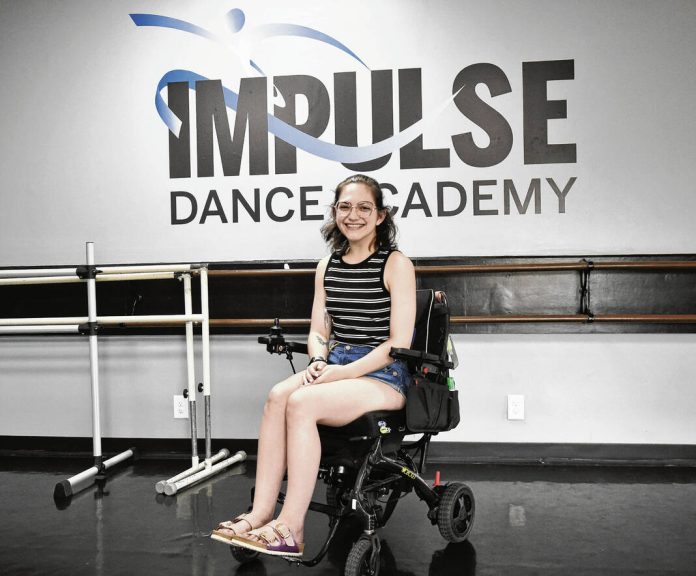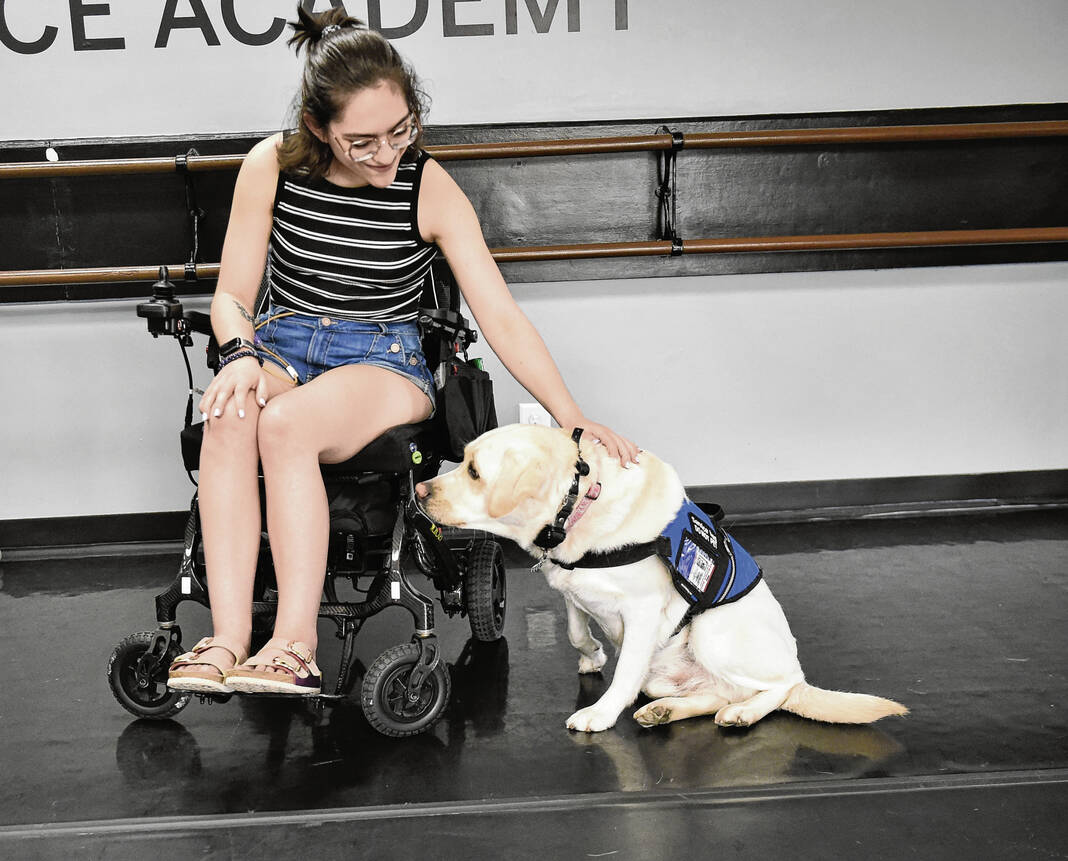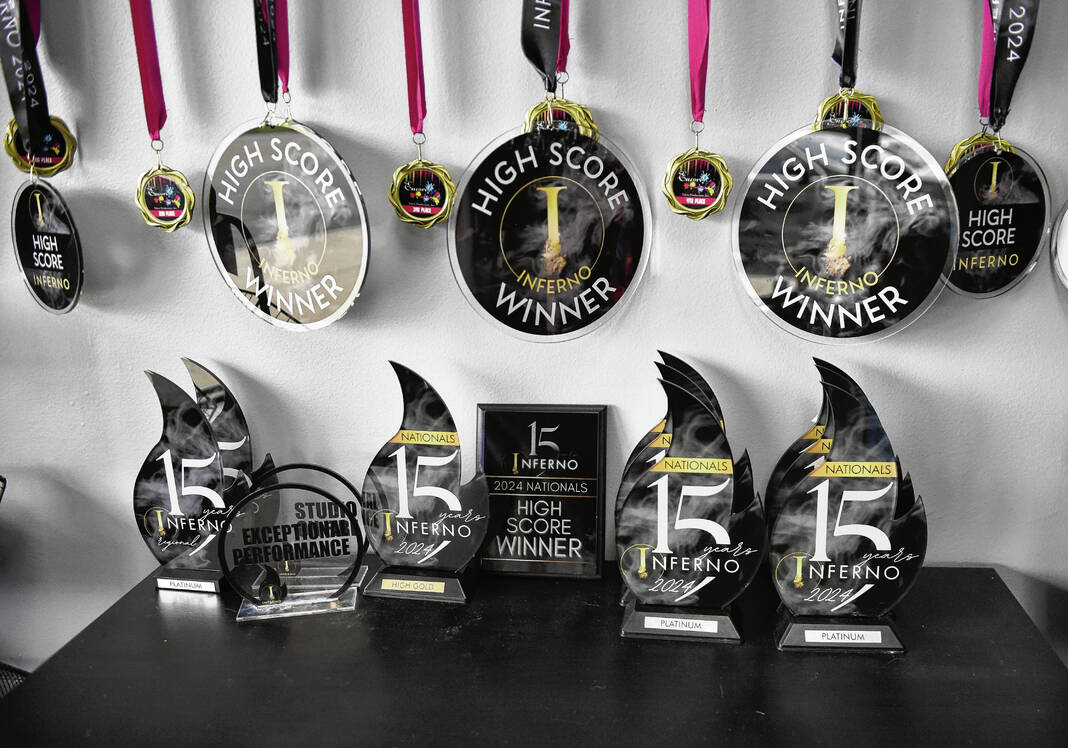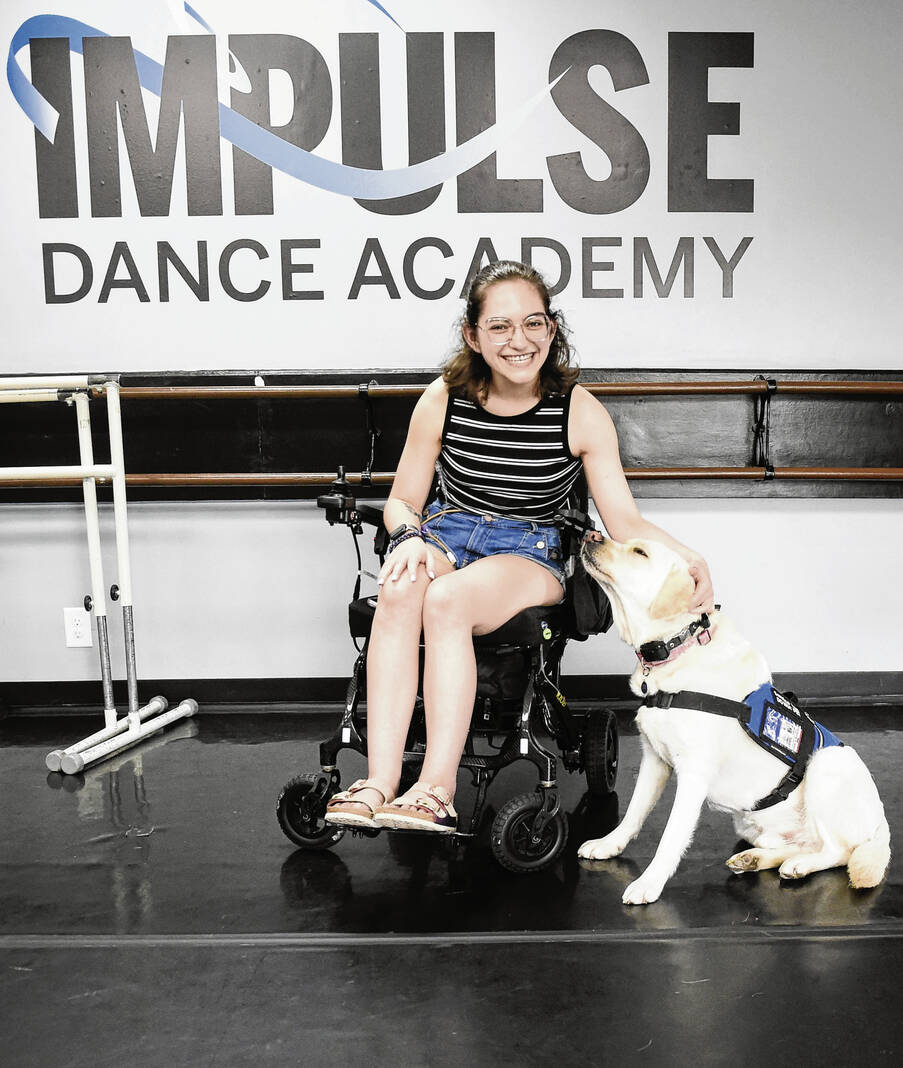
Kylie Sullivan, 23, inside the studio room at Impulse Dance Academy, where she is an instructor. Sullivan, who has been involved in dance since she was 2 years old, was diagnosed with Ehlers-Danlos syndrome, a condition that impacts her joints and other soft tissue in her body. Though she can no longer dancer herself, she still teaches and choreographs Impulse’s award-winning competition team.
RYAN TRARES | DAILY JOURNAL
Everything seemed to be crumbling away.
Kylie Sullivan had spent her life studying dance, with an eye toward making it a career.
But a mysterious condition was slowly stealing her abilities — to see, to stand and certainly to dance. The gravity of the loss weighed on her.
“It’s taken a long time to learn to separate my emotions [with] what I’m going through,” she said. “I used to let it just consume me, and cry all the time. I was so emotional and irritable.”
But Sullivan never gave up on her love of dance; rather, she adapted. She learned she suffered from Ehlers-Danlos syndrome, a condition that affects the connective tissue such as joints, organs and blood vessels throughout her body. As an instructor for Impulse Dance Academy in Greenwood, she now helps teach young dancers and choreograph award-winning routines from a wheelchair.
With the help of her service dog, Finnegan, as well as her family and other Impulse instructors, Sullivan has emphasized making the dance studio inclusive and accessible to all people. Just as dance has helped her persevere through difficulty after difficulty, the 23-year-old wants to help others harness its benefits.
“Don’t give up. There were so many times when I almost gave up. I didn’t want to keep going, but I did,” Sullivan said. “You just have to keep trying to find what you’re meant for.”
Impulse Dance Academy was founded by Sullivan’s mother, Kerri, who has more than 25 years of experience teaching dance, including an emphasis on tap, ballet, jazz, and contemporary dance. Her mission in opening Impulse was to offer a safe place for young people hoping to learn dance in a non-threatening way.
Kerri Sullivan had seen how the opposite had impacted her daughter as she struggled with her health.
“We had some issues in the past where we had dance studios in the past that were very critical, that weren’t very emotionally supportive,” Kerri Sullivan said. “We’re really trying to be here for people who might be struggling mentally or physically.”
Kylie Sullivan knew how beneficial that could be.
“Going through so many things as a kid, I was always able to rely on dance to get my emotions out,” she said.
Kylie Sullivan struggled for years growing up as the impacts of Ehlers-Danlos syndrome ravaged her body. Ehlers-Danlos is not just one condition, but a spectrum of disorders that cause joint hypermobility, skin hyperextensibility, and tissue fragility.
Though different versions of the syndrome are more or less common, it is estimated Ehlers-Danlos impacts 1 in 5,000 people globally, according to research in Denmark and Sweden reported by the Ehlers-Danlos Society.
Kylie Sullivan had been dancing since she was 2 years old, and the more she dedicated to it, the more her skills developed. She’d often put 20 hours or more into rehearsals and lessons.
But as she grew older, she found that she continuously suffered injuries doing common dance routines. Doctors initially thought she was simply hyperextending her joints.
That changed the day after her 16th birthday, when she grew ill enough to warrant a trip to the hospital — where she would stay for the next five months.
“She got to the point where she almost had no movement in her entire body. Her head would fall forward, and I’d have to lift it up for her. I’d have to feed her. It was very scary, because we didn’t realize what was going on,” Kerri Sullivan said.
Answers were difficult to come by. Her medical team didn’t know what was causing Kylie Sullivan’s maladies, even after running test after test.
Not until the family was sent to specialists at Cincinnati Children’s Hospital did the full scope of her condition come into focus.
“They finally took me seriously and told us that this was a serious condition. But it’s such a wide spectrum; some people just might hyper-extend their joints every once in a while, but for me, it impacts my whole body,” she said.
The damage caused by Ehlers-Danlos is myriad. The disease has partially paralyzed Kylie Sullivan’s stomach, making digesting food, medication and even water difficult. Her joints are so loose and unstable that the slightest movements can cause them to dislocate. Headaches are daily.
Her cardiovascular system doesn’t properly pump blood throughout her body so when she stands up, she’s at risk of fainting or passing out.
“That’s why she’s in the wheelchair — it got to the point where she could only stand for about 10 seconds before she passed out,” Kerri Sullivan said.
The constant pain and loss of what she formerly had done wore on her. To see her dreams of being a professional dancer evaporate was distressing; she struggled with depression as she coped with her condition.
Dance was an escape.
“It took a lot of therapy and healing to realize that I can be upset and angry, but I can also work through it,” she said.
With the help of her medical team, Kylie Sullivan now receives proper medication to deal with the pain that accompanies her every day. Finnegan, who became her service dog nearly five years ago, stays by her side, providing warning in case her blood pressure drops and she’s at risk of passing out.
She also found a way to put her knowledge of dance into action, albeit in a unique way. She has developed intricate choreography for students at Impulse to try on stage and in competitions. For more of the steps, she can lower herself from her wheelchair and show them the proper movements and what position they should be in.
During the Inferno Nationals dance competition in June, Impulse’s competition dance team — overseen by Kylie Sullivan — took home numerous awards.
“Instead of dancing myself on stage, I’m able to make my own choreography and see it come to life,” she said. “I get to kind of live through them. It’s really cool.”
Her journey has been a difficult one, and Kylie Sullivan knows that challenges await her. But she hopes that her experience can serve as a beacon for others experiencing something difficult in their lives.
“It was really hard to not follow the path I wanted to — not going to college for dance. But it definitely makes it up, seeing the kids come in and not be able to do a certain step at the beginning of the year, then watching them blossom into this amazing dancer and win,” she said.












